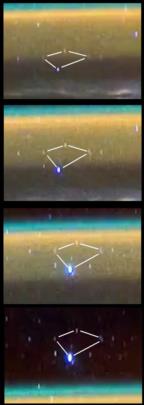
NavList:
A Community Devoted to the Preservation and Practice of Celestial Navigation and Other Methods of Traditional Wayfinding
From: Frank Reed
Date: 2016 Apr 4, 14:12 -0700
Unless we're looking at different things, I suspect the jump you're seeing is a perceptual illusion. When I let the video play at normal speed, I have the feeling of a jump near the green layer, too, but when I play it frame-by-frame, it's no longer apparent (try getting a youtube downloader app and then watch the video at slow speed).
On physical grounds, the green airglow level is way the hell up in the mesosphere. The air is far too thin up there to create any observable refraction, let alone any change in observable refraction. In the video, when you see the stars first appear above the Earth's limb but still below that green airglow, they're already above the tropopause and probably much higher. A clue to this is the fact that their brightnesses barely change in this range. There is certainly some refraction in that range, but it is very small. At the level of the green glow, atmospheric density is about 100,000 times lower than sea level. Assuming a grazing refraction of somewhat more than one degree right at sea level, call it 4000 seconds of arc, then up at that level in the mesosphere the grazing refraction is about 0.4 seconds of arc -- it's proportional to atmospheric density. The field of view is about 40° so obviously that's much less than the minimum visible scale.
There is certainly some refraction visible, but you have to look very low, just as the very brightest stars appear in the murky brown-ish part of the atmosphere along the limb, and it's only visible for about a tenth of a second. If you can find some little compact pattern of bright stars, look at the shape just as it become visible along the limb. It's flattened, but it's very difficult to detect. As the patten climbs into the golden-yellow part of the skyglow, the distortion disappears quickly. The shape is the same as it passes above the green line into the black airless sky. I'm including a few frames of this showing Canopus and nearby stars rising. Notice that the distortion is only visible only just as Canopus appears, and when its brightness is strongly diminished by extinction. The two phenomena go together: significant refraction implies significant extinction.
If anyone is trying to figure out what you're looking at in the video, the key clue is probably that sinuous red line on the ground visible from about 00:09 to 00:15 in the video. That's the brilliant lighting along the fortified Pakistan-India border (probably one of the worst places on Earth, outside a major city, to see the stars at night). The station is flying southeast towards India at that point. At timestamp 00:20 you can see the Large Magellanic Cloud rising above southern India toward the right of the frame. It's that frosty bar-shaped blob. At about that same time, dead-center in the frame just rising above the green airglow line, is the bright star Canopus.
Frank Reed
Conanicut Island USA







